[English] 日本語
 Yorodumi
Yorodumi- PDB-6rj0: Atlantic Cod Nervous Necrosis Virus-Like Particle produced in Nic... -
+ Open data
Open data
- Basic information
Basic information
| Entry | Database: PDB / ID: 6rj0 | |||||||||||||||
|---|---|---|---|---|---|---|---|---|---|---|---|---|---|---|---|---|
| Title | Atlantic Cod Nervous Necrosis Virus-Like Particle produced in Nicotiana benthamiana | |||||||||||||||
 Components Components | Coat protein | |||||||||||||||
 Keywords Keywords |  VIRUS LIKE PARTICLE / VIRUS LIKE PARTICLE /  Betanodavirus / Betanodavirus /  Virus-like particle / Virus-like particle /  Virus / Virus /  Vaccine Vaccine | |||||||||||||||
| Function / homology | Nodavirus capsid / nodavirus capsid protein / T=3 icosahedral viral capsid / Jelly Rolls - #20 /  Viral coat protein subunit / Jelly Rolls / Viral coat protein subunit / Jelly Rolls /  Sandwich / Mainly Beta / Sandwich / Mainly Beta /  Capsid protein alpha Capsid protein alpha Function and homology information Function and homology information | |||||||||||||||
| Biological species |   Betanodavirus sp. Betanodavirus sp. | |||||||||||||||
| Method |  ELECTRON MICROSCOPY / ELECTRON MICROSCOPY /  single particle reconstruction / single particle reconstruction /  cryo EM / Resolution: 3.7 Å cryo EM / Resolution: 3.7 Å | |||||||||||||||
 Authors Authors | Hurdiss, D.L. / Ranson, N.A. | |||||||||||||||
| Funding support |  United Kingdom, 4items United Kingdom, 4items
| |||||||||||||||
 Citation Citation |  Journal: Front Plant Sci / Year: 2019 Journal: Front Plant Sci / Year: 2019Title: Plant-Made Nervous Necrosis Virus-Like Particles Protect Fish Against Disease. Authors: Johanna Marsian / Daniel L Hurdiss / Neil A Ranson / Anneli Ritala / Richard Paley / Irene Cano / George P Lomonossoff /   Abstract: Virus-like particles (VLPs) of the fish virus, Atlantic Cod Nervous necrosis virus (ACNNV), were successfully produced by transient expression of the coat protein in plants. VLPs could also be ...Virus-like particles (VLPs) of the fish virus, Atlantic Cod Nervous necrosis virus (ACNNV), were successfully produced by transient expression of the coat protein in plants. VLPs could also be produced in transgenic tobacco BY-2 cells. The protein extracted from plants self-assembled into = 3 particles, that appeared to be morphologically similar to previously analyzed NNV VLPs when analyzed by high resolution cryo-electron microscopy. Administration of the plant-produced VLPs to sea bass () showed that they could protect the fish against subsequent virus challenge, indicating that plant-produced vaccines may have a substantial future role in aquaculture. | |||||||||||||||
| History |
|
- Structure visualization
Structure visualization
| Movie |
 Movie viewer Movie viewer |
|---|---|
| Structure viewer | Molecule:  Molmil Molmil Jmol/JSmol Jmol/JSmol |
- Downloads & links
Downloads & links
- Download
Download
| PDBx/mmCIF format |  6rj0.cif.gz 6rj0.cif.gz | 99.7 KB | Display |  PDBx/mmCIF format PDBx/mmCIF format |
|---|---|---|---|---|
| PDB format |  pdb6rj0.ent.gz pdb6rj0.ent.gz | 78.7 KB | Display |  PDB format PDB format |
| PDBx/mmJSON format |  6rj0.json.gz 6rj0.json.gz | Tree view |  PDBx/mmJSON format PDBx/mmJSON format | |
| Others |  Other downloads Other downloads |
-Validation report
| Arichive directory |  https://data.pdbj.org/pub/pdb/validation_reports/rj/6rj0 https://data.pdbj.org/pub/pdb/validation_reports/rj/6rj0 ftp://data.pdbj.org/pub/pdb/validation_reports/rj/6rj0 ftp://data.pdbj.org/pub/pdb/validation_reports/rj/6rj0 | HTTPS FTP |
|---|
-Related structure data
| Related structure data |  4899MC M: map data used to model this data C: citing same article ( |
|---|---|
| Similar structure data |
- Links
Links
- Assembly
Assembly
| Deposited unit | 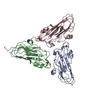
|
|---|---|
| 1 | x 60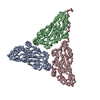
|
- Components
Components
| #1: Protein | Mass: 36903.711 Da / Num. of mol.: 3 Source method: isolated from a genetically manipulated source Source: (gene. exp.)   Betanodavirus sp. / Production host: Betanodavirus sp. / Production host:   Nicotiana benthamiana (plant) / References: UniProt: Q91D83*PLUS Nicotiana benthamiana (plant) / References: UniProt: Q91D83*PLUS |
|---|
-Experimental details
-Experiment
| Experiment | Method:  ELECTRON MICROSCOPY ELECTRON MICROSCOPY |
|---|---|
| EM experiment | Aggregation state: PARTICLE / 3D reconstruction method:  single particle reconstruction single particle reconstruction |
- Sample preparation
Sample preparation
| Component | Name: Betanodavirus sp. / Type: VIRUS / Entity ID: all / Source: RECOMBINANT |
|---|---|
| Molecular weight | Value: 7.7 MDa / Experimental value: NO |
| Source (natural) | Organism:   Betanodavirus sp. Betanodavirus sp. |
| Source (recombinant) | Organism:   Nicotiana benthamiana (plant) Nicotiana benthamiana (plant) |
| Details of virus | Empty: YES / Enveloped: NO / Isolate: STRAIN / Type: VIRUS-LIKE PARTICLE |
| Natural host | Organism: Gadus morhua |
| Virus shell | Triangulation number (T number): 3 |
| Buffer solution | pH: 7.2 Details: PBS (140 mM NaCl, 15 mM KH2PO4, 80 mM Na2HPO4, 27 mM KCl, pH 7.2) |
| Specimen | Conc.: 0.9 mg/ml / Embedding applied: NO / Shadowing applied: NO / Staining applied : NO / Vitrification applied : NO / Vitrification applied : YES : YES |
| Specimen support | Grid material: COPPER / Grid mesh size: 200 divisions/in. / Grid type: Quantifoil R2/2 |
Vitrification | Instrument: LEICA EM GP / Cryogen name: ETHANE / Humidity: 85 % / Chamber temperature: 281 K |
- Electron microscopy imaging
Electron microscopy imaging
| Experimental equipment |  Model: Titan Krios / Image courtesy: FEI Company |
|---|---|
| Microscopy | Model: FEI TITAN KRIOS |
| Electron gun | Electron source : :  FIELD EMISSION GUN / Accelerating voltage: 300 kV / Illumination mode: FLOOD BEAM FIELD EMISSION GUN / Accelerating voltage: 300 kV / Illumination mode: FLOOD BEAM |
| Electron lens | Mode: BRIGHT FIELD Bright-field microscopy / Nominal defocus max: 2500 nm / Nominal defocus min: 500 nm Bright-field microscopy / Nominal defocus max: 2500 nm / Nominal defocus min: 500 nm |
| Specimen holder | Cryogen: NITROGEN / Specimen holder model: FEI TITAN KRIOS AUTOGRID HOLDER |
| Image recording | Average exposure time: 2 sec. / Electron dose: 45 e/Å2 / Detector mode: COUNTING / Film or detector model: GATAN K2 SUMMIT (4k x 4k) / Num. of real images: 2359 |
| Image scans | Movie frames/image: 20 |
- Processing
Processing
| Software | Name: PHENIX / Version: 1.11.1_2575: / Classification: refinement | ||||||||||||||||||||||||||||||||||||
|---|---|---|---|---|---|---|---|---|---|---|---|---|---|---|---|---|---|---|---|---|---|---|---|---|---|---|---|---|---|---|---|---|---|---|---|---|---|
| EM software |
| ||||||||||||||||||||||||||||||||||||
CTF correction | Type: PHASE FLIPPING AND AMPLITUDE CORRECTION | ||||||||||||||||||||||||||||||||||||
| Particle selection | Num. of particles selected: 20887 | ||||||||||||||||||||||||||||||||||||
| Symmetry | Point symmetry : I (icosahedral : I (icosahedral ) ) | ||||||||||||||||||||||||||||||||||||
3D reconstruction | Resolution: 3.7 Å / Resolution method: FSC 0.143 CUT-OFF / Num. of particles: 16616 / Symmetry type: POINT | ||||||||||||||||||||||||||||||||||||
| Atomic model building | B value: 137 / Protocol: RIGID BODY FIT / Space: REAL / Target criteria: Cross-correlation coefficient | ||||||||||||||||||||||||||||||||||||
| Atomic model building | PDB-ID: 4WIZ |
 Movie
Movie Controller
Controller


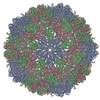
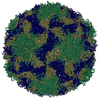
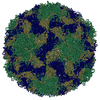
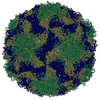
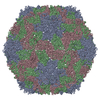
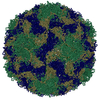
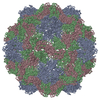
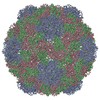
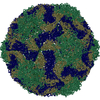
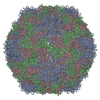
 PDBj
PDBj


